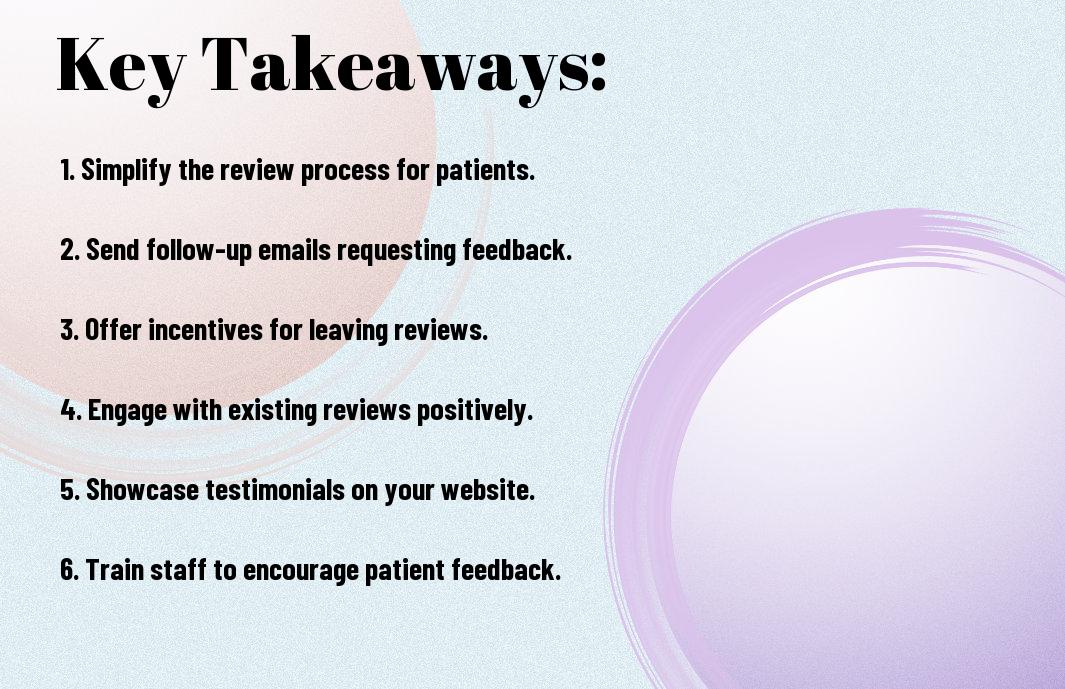What Strategies Encourage Patient Reviews To Optimize Your GMB?
It’s imperative for your practice to harness the power of patient reviews to enhance your Google My Business (GMB) listing. By implementing effective strategies, you can significantly boost your online presence and build trust with potential patients. In this post, I will share key techniques that not only encourage patient feedback but also make it easier for you to manage and respond to reviews effectively. Let’s explore how positive patient experiences can lead to more accolades on your GMB and ultimately enhance your practice’s reputation.
Key Takeaways:
- Engagement: Actively interact with patients on various platforms to build trust and encourage feedback.
- Incentives: Offer small rewards or incentives for leaving a review, enhancing motivation for patients.
- Timing: Request reviews shortly after appointments while the experience is still fresh in patients’ minds.
- Simplicity: Make the review process easy by providing clear instructions and direct links to your GMB page.
- Follow-up: Send follow-up emails or messages thanking patients and gently reminding them to leave a review.
- Highlight positive feedback: Share positive reviews on social media and your website to motivate others to share their experiences.
- Monitor reviews: Regularly check reviews to respond promptly, showing that you value patient feedback and engagement.
Understanding the Importance of Patient Reviews
A wealth of information can be gleaned from the way patients express their experiences with your practice. By understanding the significance of these reviews, I can better guide you to utilize them in a beneficial manner. Patient reviews not only offer feedback for improvement but also serve as a critical touchpoint for potential new patients. Enhancing your presence and reputation through positive reviews can differentiate you from competitors and establish trust in your community.
Impact on Local SEO
Behind every patient review lies an opportunity to impact your online visibility in local search results. Google prioritizes businesses with a higher volume of positive reviews in its local search rankings, which directly influences how often your practice appears in search query outcomes. The more reviews you have, and the better your overall rating, the stronger your GMB (Google My Business) profile will be, aiding in attracting more patients who are searching for medical services similar to yours.
Influence on Patient Decisions
Importance is placed on patient reviews as they significantly affect your potential patients’ choices. Studies have shown that the majority of individuals consult online reviews before making healthcare decisions; almost 80% of patients trust online reviews as much as personal recommendations. When you engage with these reviews—both positive and negative—you demonstrate to prospective patients that you value feedback and are committed to improvement and quality care.
This highlights how patient reviews are not merely a metric of satisfaction, but instead they carry weight in how prospects perceive and engage with your practice. They help form first impressions, and potential patients often equate a multitude of positive reviews with quality and reliability. It’s evident that actively managing and encouraging reviews can not only enhance your online reputation but also drive more patients through your doors, ultimately impacting your practice growth and success.

Strategies to Solicit Patient Reviews
Some of the most effective strategies to solicit patient reviews involve understanding when and how to ask for them. Timing plays a significant role in whether or not a patient will take the time to share their experience. I suggest approaching patients shortly after their appointment or treatment while the experience is still fresh in their minds. You might consider utilizing techniques such as providing a simple, straightforward request during a follow-up conversation or even sending a text or email. Others find success in offering clear instructions on how to leave a review, perhaps through a direct link that you provide, making it as easy as possible for them to submit their feedback.
Timing and Techniques for Requesting Reviews
Techniques can also be tailored to fit the individual preferences of your patients. Personalizing your request not only shows that you value their opinion but also increases the likelihood they will respond positively. For instance, if you notice a patient has expressed satisfaction during their visit, take that opportunity to gently ask if they’d be willing to leave a review for your practice. It’s important to be genuine and to convey why their feedback matters; this connects them to your practice on a deeper level and provides a sense of contribution to their community.
Utilizing Follow-Up Communication
Behind every compelling review, there is often a follow-up communication that prompts it. After an appointment, following up with a patient demonstrates that you care about their experience beyond their time in your office. This can take the form of a thank-you email or a phone call checking in on their health. In these communications, you should feel free to gently remind them how important their feedback is and encourage them to share their thoughts online. I find that patients are much more likely to write a review when they feel their experience has been valued.
In addition, you could implement automated systems to schedule these follow-up communications, ensuring that they are consistently timed and targeted. Make sure to use this opportunity not only to ask for feedback but also to address any concerns that might not have been openly discussed during the visit. This can turn a potentially negative experience into a positive one, encouraging your patients to transform their feelings into thoughtful reviews that enhance your online reputation.

Creating a Supportive Environment for Reviews
Once again, establishing a welcoming atmosphere for patient reviews can significantly impact your Google My Business (GMB) profile. Patients are more inclined to leave reviews when they feel a positive connection with your practice. It’s imperative to foster a culture that values feedback, making it a natural extension of the patient experience. For more information on enhancing your online presence, check out How to Optimize Your Healthcare Google Business Profile …
Staff Training and Engagement
Reviews play an integral role in shaping the public’s perception of your practice. Therefore, it’s vital to equip your team with the skills and knowledge to engage effectively with patients. Training sessions that emphasize the importance of patient feedback will inspire staff to actively seek reviews. Engaged staff members are often seen as brand ambassadors, and their positive interactions can motivate patients to share their experiences online.
Enhancing Patient Experience
By prioritizing the patient experience, you can create an environment that encourages reviews. Focusing on personalized care, alleviating anxiety, and streamlining processes can make a significant difference in how patients perceive your practice. When patients feel valued and heard, they are more likely to express their satisfaction through online reviews, thus boosting your GMB presence.
Also, consider implementing feedback mechanisms at various touchpoints during the patient journey. Simple follow-up emails or SMS messages thanking them for their visit, along with a request for a review, can be effective. This not only keeps you top-of-mind for the patient but also shows that you value their input. Creating a seamless process for leaving reviews allows for a more positive experience. The key is to ensure that the instruction on how to leave a review is clear and straightforward, providing patients with every opportunity to share their positive experiences.
Leveraging Social Media and Online Presence
Many practitioners are discovering the importance of harnessing the power of social media and a solid online presence to encourage patient reviews. Social platforms not only provide a channel for your existing patients to share their experiences but also serve as a stage to attract new patients who are influenced by peer recommendations. By actively engaging with your audience on platforms like Facebook, Instagram, and Twitter, I have found that I can effectively promote the idea of submitting reviews. This engagement can take the form of posts that outline how important reviews are for the growth of the practice, sharing positive testimonials, or even encouraging patients to tag your practice in their posts following an appointment.
Promoting Reviews on Social Platforms
Below are some effective strategies that I have implemented to promote reviews on my social media platforms. Creating visually appealing graphics or quick video snippets that invite patients to share their experiences can significantly boost engagement. Furthermore, offering regular incentives, such as a chance to win a gift card or a free service for anyone who leaves a review, can catalyze the review process. It’s necessary to regularly remind your audience of the positive impact their feedback creates, not just for your practice, but for potential new patients seeking quality care.
Integrating Reviews into Your Website
Social proof plays a significant role in building trust and credibility among potential patients, and integrating reviews into your website is a powerful strategy. Integrating patient testimonials directly onto your practice’s website serves multiple purposes. First, it allows visitors to easily see the positive feedback from your current patients, which can influence their decision to book an appointment. Additionally, highlighting specific reviews, particularly those that touch on key areas such as customer service, medical expertise, and overall patient satisfaction, can reinforce the strengths of your practice. This visibility not only enhances your online reputation but also aligns with your efforts to drive higher GMB ratings.
Integrating reviews into your website can be as simple as embedding a review widget that showcases real-time feedback from platforms like Google My Business and Yelp. This feature not only keeps your website current but also allows for ultimate transparency with potential patients. Moreover, parallel links to social media where older testimonials can be found encourage visitors to explore further, enhancing their perception of your practice’s engagement with existing patients.
Responding to Patient Feedback
Despite the inherent challenges, actively engaging with patient feedback through responses can significantly enhance my practice’s online reputation. When patients take the time to share their experiences, be they positive or negative, they provide valuable insights that can contribute to the ongoing improvement of services and patient satisfaction. By responding thoughtfully, I not only show appreciation for their input but also demonstrate that I value patient opinions and encourage further engagement.
Best Practices for Replying to Reviews
Practices surrounding replies should be straightforward yet thoughtful. I aim to personalize responses, addressing the reviewer by name when possible, which helps establish a connection. It’s important to maintain a professional tone while expressing gratitude for positive reviews and understanding toward negative feedback. Timeliness is also key; I strive to respond as soon as possible, optimizing my engagement with patients and creating a positive impression of my practice.
Managing Negative Feedback Constructively
Behind every negative review lies an opportunity for improvement. I approach these situations with empathy, recognizing that a dissatisfied patient might simply be voicing a concern that has merit. Addressing the feedback relevantly means acknowledging their experience and considering a solution or clarifying any misunderstandings. This not only helps resolve the issue but also showcases my commitment to patient care.
This approach can be especially effective, as it allows me to demonstrate my willingness to adapt and grow. By responding publicly to negative feedback, I can turn a potentially damaging situation into a positive one, showing other patients that I take concerns seriously. I keep my replies composed and constructive, reinforcing that I genuinely value all patient input. The key lies in maintaining positivity while addressing the specific issues patients raise, which can lead to improved relationships and even convert unhappy patients into loyal advocates for my practice.

Monitoring and Analyzing Review Trends
For healthcare providers, actively monitoring and analyzing patient reviews can provide invaluable insights into the services offered and patient satisfaction. By paying close attention to these reviews, I can better understand trends and patterns that emerge over time. This allows me to pinpoint areas where patient experiences are falling short or exceeding expectations. With this knowledge, I can implement meaningful changes to enhance the quality of care I provide, ultimately leading to a stronger online reputation and increased patient trust.
Tools for Tracking Patient Reviews
Across the digital landscape, there are numerous tools available that can help you track patient reviews effectively. Platforms such as Google Alerts, Hootsuite, or specialized review management software can monitor online conversations surrounding your practice. These tools notify you when new reviews are posted, allowing you to respond promptly and engage with your patients effectively. By utilizing these resources, I can ensure that no feedback goes unnoticed, fostering a more positive relationship with the individuals I serve.
Adapting Strategies Based on Feedback
Strategies for adapting based on patient feedback should be proactive and transparent. By analyzing both positive and negative reviews, I can identify not just what is working well, but also the recurring issues that need attention. This iterative process of shifting strategies allows me to maintain a high standard of patient care and continuously evolve to meet patient needs. Each piece of feedback adds valuable context that can guide my approach and help to cultivate a more patient-centered practice.
A deeper examine patient feedback can reveal significant opportunities for improvement. Common themes in negative reviews often indicate systemic issues within operations, while positive testimonials can highlight strengths I may want to promote further. Acting on these insights can demonstrate to patients that their opinions matter, building trust and encouraging them to leave more reviews in the future. By adapting my approach based on this feedback, I not only enhance my services but also solidify a loyal patient base committed to my practice’s continual growth.
Summing up
Following this, I encourage you to implement the strategies we’ve discussed to enhance patient reviews and optimize your Google My Business (GMB) listing. By actively engaging with your patients and requesting feedback at strategic moments, you can significantly increase the quantity and quality of reviews that reflect your practice’s values and care. Personalizing your communication, making it easy for patients to leave reviews, and showing appreciation for their feedback are all effective ways to cultivate a positive review environment. This not only boosts your online presence but can also attract new patients seeking your services.
Furthermore, leveraging tools and insights from platforms such as 11 Strategies to Boost Your Google Reviews can provide you with additional techniques to amplify your success. Consistency in asking for reviews and effectively responding to patients can build a trustworthy reputation and enhance your relationship with them. By following these strategies, I’m confident you’ll see a positive impact on your GMB performance and overall patient satisfaction.
FAQ
Q1: Why are patient reviews important for my Google My Business listing?
A: Patient reviews play a significant role in enhancing your online presence and credibility. They not only influence potential patients’ decision-making but also improve your Local SEO ranking, making it easier for people in your area to find your practice. Positive reviews build trust and convey the quality of care that others have received at your facility.
Q2: What are some effective ways to ask patients for reviews?
A: You can ask patients for reviews at different touchpoints during their experience. This can include after a consultation or treatment when they express satisfaction. Providing easy instructions on how to leave a review—such as sending a follow-up email with a direct link to your Google My Business page—can simplify the process for them.
Q3: Should I offer incentives for patient reviews?
A: Offering incentives can be a grey area. While encouraging reviews is important, it’s best to avoid anything that could be perceived as bribery. Instead, you might consider highlighting that you value their feedback and that honest reviews help improve future services. Focusing on service quality will naturally encourage positive responses.
Q4: How can I make it easy for patients to leave reviews?
A: Simplifying the review process for patients is key. You can create a streamlined pathway by providing tips or a step-by-step guide. Additionally, placing signage in your practice with QR codes that link directly to your Google review page can facilitate the process, making it quick and convenient.
Q5: What type of messaging resonates most with patients when asking for reviews?
A: Personalizing your approach can significantly increase the likelihood of receiving reviews. Tailor your requests by making them feel genuine and sincere. Phrases that express gratitude for their visit and emphasize the importance of their feedback in helping others will resonate positively. For example, you can say, “Your experience matters to us, and we’d love for you to share it.”
Q6: How should I respond to negative reviews on my GMB listing?
A: Addressing negative reviews thoughtfully is important for maintaining your online reputation. Always respond professionally and courteously, acknowledging the patient’s concerns and expressing a desire to resolve the issue. Show that you value their feedback and are committed to improving your practice. This shows prospective patients that you take criticism seriously and are proactive in addressing issues.
Q7: Can I use social media to encourage more patient reviews?
A: Absolutely! Social media is a powerful tool to engage with your audience and encourage reviews. You can share success stories, testimonials, or posts highlighting patient satisfaction. Including a call-to-action in your social media content, inviting patients to leave reviews on your Google My Business page, can significantly boost response rates.





